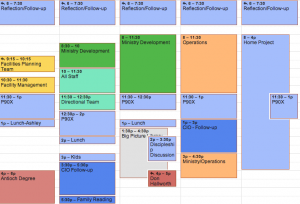In my last post I gave the first 3 steps to my weekly review:
1. Review notes from previous week
2. Review previous weeks tasks and projects
3. Look at my week ahead – meetings, appointments and projects
The next two steps are the crucial planning for your week. Without absolute clarity on how you will tackle your week, you will be a victim of your schedule rather than a captain of your vision moving forward.

4. The action sheet – this is a list of what I want to move forward this week broken down by roles I fulfill in life and ministry. I want to emphasize that this is not just work stuff, these are genuinely my roles in my life, family and ministry. This concept I’ve borrowed from Steven Covey again and like how his approach acts as a compass for what I value. In each category I am looking at how I will move forward in each role based on goals I’ve set for the year.
Disciple – what will I being do this week to continue growing in my appreciation for the Gospel. This is a “not urgent – important” category that if I’m not staying focused on, will be crowded out. This could include a goal to memorize a verse, study time through a book in the Bible etc..
Blogger – I record my action list for what I want to move forward with my blog, I review my blog post drafts and when I will complete and post the next updates.
Husband – What intentional things will I do in my marriage this week – write a note, words of affirmation, quality time, encouraging my wife’s gifting?
Father – what intentional things will I do to encourage my children? Again…quality time, activities, intentional teaching/training.
Pastor – How will I grow my pastoral shepherding ministry? Who will I encourage this week? Who do I need to speak with, call or send a note?
Ministry Overseer – Core role in my career – a review of my projects I’m involved in and collaborating on.
Operations Overseer – Another core role in my career – review of departmental direction and projects I’m moving forward with the team.
5. Plug the Action List into Google Calendar – In a previous post I discussed how I use my morning review to tackle a tough day. My daily review is really a “tweaking” of what I’ve laid out for the week. I Recognize that as the week unfolds we have to be flexible to the crisis that hit our desk. However, by reviewing my goals and planning what I want to move forward this week, I am able to make tweaks on a daily basis that give me just enough latitude to stay on track and not abandon my goals.

After I’ve done all of this I give a last look to make sure that I’m being bold – but not unrealistic. There is nothing more deflating that moving most of what you were going to do this week to next week….trust me I’ve done that. By have a bold agenda I find that it breaths life into my busy life and provides passion to what could at times just be a list of tasks.
How do you move goals forward with your busy schedule?





















